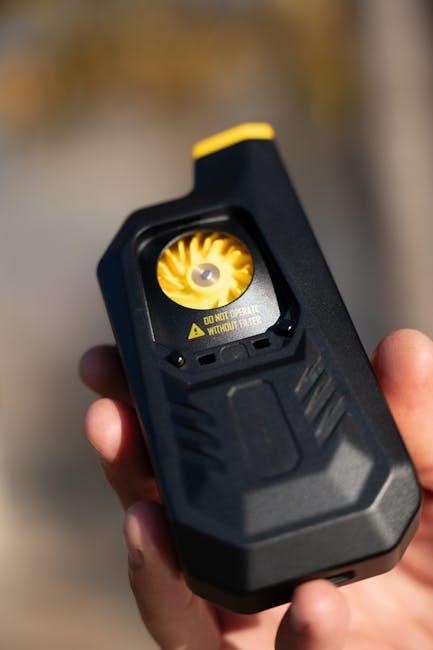Welcome to the comprehensive guide for your Fluke 289 True-RMS Digital Multimeter. This manual provides detailed instructions and information to help you effectively use and maintain your Fluke 289. It covers essential aspects such as safety guidelines, operation, and troubleshooting, ensuring optimal performance and longevity of your device.
Overview of Fluke 289

The Fluke 289 is a high-performance industrial logging multimeter designed for solving complex problems in electronics, plant automation, power distribution, and electro-mechanical equipment. As a next-generation DMM, it’s engineered to serve as your reliable watchdog for critical systems and processes. Compatible with Fluke Connect, the 289 offers advanced connectivity options, enabling seamless data transfer and remote monitoring.
This multimeter is part of the Fluke 289 series, known for its True-RMS accuracy and comprehensive measurement capabilities. It can measure AC and DC voltage up to 1000V and as low as 0.001V DC, along with AC and DC current up to 10A. The 289 also handles resistance measurements up to 500 megaohms, capacitance, temperature, and frequency, making it a versatile tool for various applications.
The Fluke 289 features manual and automatic ranging, display hold, auto hold, and Min/Max-Average recording. It is designed for users who need a reliable and feature-rich multimeter for demanding industrial environments, offering the precision and functionality required for advanced troubleshooting and diagnostics.
Key Features and Capabilities
The Fluke 289 boasts a range of features that make it an indispensable tool for professionals. Its True-RMS accuracy ensures precise measurements in complex AC environments. The multimeter provides both manual and automatic ranging options, allowing users to select the most appropriate setting for their specific task. Display Hold and Auto Hold functions capture stable readings for easy recording and analysis; The Min/Max-Average recording feature tracks signal fluctuations over time.
Additionally, the Fluke 289 offers extensive measurement capabilities, including AC and DC voltage, current, resistance, capacitance, temperature, and frequency. Its Fluke Connect compatibility enables wireless data transfer and remote monitoring, enhancing productivity and safety. The high-resolution display provides clear and detailed readings, while the intuitive user interface simplifies navigation and operation. The device is ruggedly built to withstand harsh industrial environments, ensuring reliable performance in demanding conditions.

The Fluke 289 stands out as a versatile and powerful tool for advanced troubleshooting and diagnostics, making it an ideal choice for professionals who require precision, reliability, and advanced functionality in their daily work.
Powering the Meter On and Off
To power on the Fluke 289 multimeter, simply press the power button located on the front panel. A brief press will activate the meter, and the display will illuminate, showing the current settings and measurement mode. Ensure the battery is adequately charged before use to prevent unexpected shutdowns during operation. If the meter fails to power on, check the battery level and replace or recharge as needed.
To power off the Fluke 289, press and hold the power button for a few seconds until the display turns off. The meter also features an automatic power-off function, which activates after a period of inactivity to conserve battery life. This feature can be configured in the meter’s settings menu to suit individual preferences. When storing the meter for extended periods, it is recommended to remove the batteries to prevent potential leakage and corrosion that could damage the device.
Properly powering the meter on and off is crucial for ensuring both its functionality and longevity. Familiarize yourself with the power button and automatic shut-off settings for optimal use.
Battery Level and Management
The Fluke 289 features a clear battery level indicator on the display, providing a visual representation of the remaining battery capacity. Regularly monitor this indicator to ensure sufficient power for your measurements. When the battery level is low, a warning icon will appear, signaling the need for replacement or recharging. Ignoring this warning may result in inaccurate readings or unexpected shutdowns during critical tasks.
To maximize battery life, the Fluke 289 incorporates a battery saver mode, which automatically reduces the display brightness and disables certain features when the meter is idle. You can customize the duration before the battery saver mode activates in the settings menu. It is advisable to use high-quality batteries and follow proper charging procedures to prolong the battery’s lifespan and maintain optimal performance. Avoid exposing the meter to extreme temperatures, as this can negatively impact battery performance and longevity.
When replacing batteries, ensure you use the correct type and follow the polarity markings inside the battery compartment. Dispose of used batteries responsibly, adhering to local regulations. Proper battery management is essential for reliable operation and extending the life of your Fluke 289.
Controlling the Backlight
The Fluke 289 is equipped with a backlight feature to enhance visibility in dimly lit environments. Adjusting the backlight is simple and allows you to optimize the display for various lighting conditions, ensuring clear and accurate readings at all times. To activate or deactivate the backlight, locate the dedicated button on the meter’s front panel, typically indicated by a lightbulb icon. Pressing this button will toggle the backlight on or off.
In addition to the on/off functionality, the Fluke 289 may offer adjustable brightness levels for the backlight. This feature allows you to further customize the display’s visibility and conserve battery power. To adjust the brightness, navigate to the meter’s settings menu and locate the backlight options. From there, you can select the desired brightness level, ranging from low to high, or even set it to automatically adjust based on ambient light conditions.
Using the backlight judiciously can significantly extend battery life. Consider turning it off when working in well-lit areas or setting it to a lower brightness level when full illumination is not necessary. Proper management of the backlight ensures optimal visibility while minimizing power consumption.
Measurement Functions
The Fluke 289 is a versatile digital multimeter offering a wide array of measurement functions to cater to diverse electrical and electronic testing needs. These functions include AC and DC voltage measurement, enabling accurate assessment of electrical potential in various circuits. Resistance measurement is also supported, allowing users to determine the opposition to current flow in components and circuits. Additionally, the Fluke 289 can measure AC and DC current, crucial for analyzing circuit behavior and identifying potential issues.
Beyond the standard measurements, the Fluke 289 boasts advanced capabilities such as capacitance measurement, essential for evaluating capacitor performance. It also features frequency measurement, enabling precise determination of signal frequencies in electronic circuits. Temperature measurement is another valuable function, allowing users to assess thermal conditions using thermocouples. Furthermore, the Fluke 289 incorporates diode test and continuity test functions, facilitating component-level troubleshooting;

With its comprehensive set of measurement functions, the Fluke 289 empowers technicians and engineers to perform thorough diagnostics and analysis across a broad spectrum of electrical and electronic systems, ensuring accurate and reliable results.
Calibration Information
Maintaining the accuracy of your Fluke 289 is crucial for reliable measurements, and regular calibration is essential for achieving this. Calibration is the process of comparing the meter’s readings against known standards to ensure they fall within specified accuracy limits. Fluke recommends calibrating the 289 annually to guarantee its performance meets original specifications.
The Fluke 289 should be calibrated by qualified personnel using calibrated equipment traceable to national or international standards. Transcat offers ISO/IEC 17025 accredited calibration services for Fluke instruments. Calibration involves adjusting the meter to minimize errors and verifying its performance across various measurement ranges and functions.
Traceability is a key aspect of calibration, ensuring that the standards used are linked to a recognized authority. A calibration certificate provides documentation of the calibration process, including the standards used, measurement results, and any adjustments made. This certificate serves as proof of the meter’s accuracy and traceability. For calibration services, contact Fluke customer service or an authorized service provider.
Safety Guidelines
Prioritizing safety is paramount when operating the Fluke 289 True-RMS Digital Multimeter. Always adhere to the following safety guidelines to prevent electrical shock, personal injury, or damage to the meter.
Before using the Fluke 289, carefully read and understand the entire user manual. Ensure the meter is in good working condition, with no visible damage to the case, test leads, or connectors. Never use the meter if it appears damaged or if you suspect it is not functioning properly.

Always use the correct test leads and accessories that meet the safety ratings appropriate for the measurement environment. When measuring voltage, start with the highest range and gradually decrease it to obtain the most accurate reading. Be cautious when working with voltages above 30V AC or 60V DC, as these levels pose a shock hazard. Never apply more than the rated voltage between any terminal and earth ground.
Disconnect the meter from the circuit before opening the case for battery replacement or any other maintenance. Do not operate the meter in wet or hazardous locations.
Troubleshooting Tips
Encountering issues with your Fluke 289? Here are some helpful troubleshooting tips to resolve common problems. If the meter fails to power on, first check the battery level indicator. Replace the batteries if they are low or depleted, ensuring they are correctly installed with the proper polarity.
If the display is blank or unreadable, verify that the backlight is enabled and adjusted to an appropriate brightness level. If the meter displays erratic or inaccurate readings, ensure the test leads are securely connected to both the meter and the circuit under test. Check for any signs of damage or contamination on the test leads, and replace them if necessary.
If you suspect the meter is not measuring correctly, perform a self-test to check its internal functions. Consult the user manual for instructions on running a self-test. For resistance measurements, ensure the circuit is de-energized before connecting the meter. If the issue persists, refer to the calibration information in the manual or contact Fluke customer service for further assistance.
Contacting Fluke Customer Service
If you require assistance beyond the troubleshooting tips provided in this manual, Fluke Customer Service is available to help. For immediate support, you can call their customer service line at 1-800-753-7970. Their knowledgeable support specialists can assist with technical inquiries, product support, and general questions about your Fluke 289.
Alternatively, you can reach out to Fluke Customer Service via email. Visit the Fluke website and navigate to the “Contact Us” section to find the appropriate email address for your region or specific inquiry. When contacting customer service, please have your Fluke 289 model number and serial number readily available, as well as a detailed description of the issue you are experiencing.
Fluke also offers online resources such as FAQs, knowledge base articles, and user forums where you may find answers to common questions. Before contacting customer service, consider exploring these resources for quick solutions. If you’ve received an error message in error, contact eCommerce Customer Support. Fluke is committed to providing excellent customer service and support for all its products.
Available Manual Downloads
To ensure you always have access to the most up-to-date information for your Fluke 289 True-RMS Digital Multimeter, we provide several manual download options. You can download the complete user manual in PDF format directly from the Fluke website. This comprehensive manual includes detailed instructions, specifications, safety guidelines, and troubleshooting tips.
In addition to the full user manual, we also offer quick reference guides and application notes that cover specific aspects of the Fluke 289’s operation. These resources can be particularly helpful for users who need a quick refresher on a particular feature or function. To access these downloads, visit the Fluke website and navigate to the “Support” section. Enter “Fluke 289” in the search bar to find all available documentation.
Make sure to check back periodically for updated versions of the manuals, as Fluke regularly releases new information and improvements. Downloading the latest manual ensures you have the most accurate and complete information for your Fluke 289.
